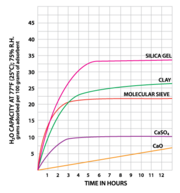Difference between revisions of "Desiccant"
Jump to navigation
Jump to search


| Line 1: | Line 1: | ||
| − | [[File:Dessicant capacity chart.png|thumb|Desiccant Capacity chart (hours) | + | [[File:Dessicant capacity chart.png|thumb|Desiccant Capacity chart (hours); [https://www.sorbentsystems.com/desiccants_charts.html Sorbent Systems] ]] |
| − | [[File:Desicant capaity chart RH.png|thumb|Desiccant Capacity chart (RH) | + | [[File:Desicant capaity chart RH.png|thumb|Desiccant Capacity chart (RH); [https://www.sorbentsystems.com/desiccants_charts.html Sorbent Systems] ]] |
== Description == | == Description == | ||
Revision as of 16:14, 9 July 2023

Desiccant Capacity chart (hours); Sorbent Systems

Desiccant Capacity chart (RH); Sorbent Systems
Description
A hygroscopic substance that will remove water vapor from the air. Desiccants are used as drying agents. Some desiccants are chemically inert and may be dried in an oven and reused, such as silica gel. Other desiccants are react with water; these require special handling techniques.
Examples are Activated carbon, Aerogel, Activated alumina, Calcium chloride, Calcium oxide, Calcium sulfate, Clay, molecular sieves, Potassium carbonate, Potassium hydroxide, Rice, Silica gel, Sodium, Sodium chlorate, Sodium chloride, Sodium hydroxide, Sodium sulfate, Sucrose and Zinc chloride.
Synonyms and Related Terms
drier; drying agent; dessicant (sp); sorbent; scavenger
Resources and Citations
- Sorbent Systems: Desiccant Charts
- Theodore J. Reinhart, 'Glossary of Terms', Engineered Plastics, ASM International, 1988
- Richard S. Lewis, Hawley's Condensed Chemical Dictionary, Van Nostrand Reinhold, New York, 10th ed., 1993
- Dictionary of Building Preservation, Ward Bucher, ed., John Wiley & Sons, Inc., New York City, 1996
- The American Heritage Dictionary or Encarta, via Microsoft Bookshelf 98, Microsoft Corp., 1998